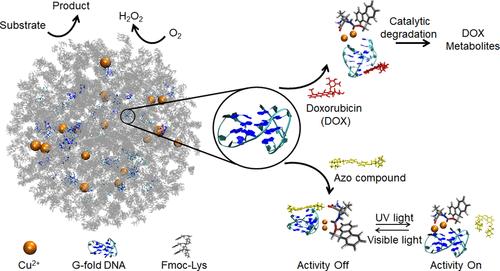当前位置:
X-MOL 学术
›
Chem. Mater.
›
论文详情
Our official English website, www.x-mol.net, welcomes your feedback! (Note: you will need to create a separate account there.)
Self-Assembled G-fold DNA/Amino Acid Amphiphiles-Based Oxidase-Mimetic Materials Exhibiting Drug-Degrading and Photoswitchable Capabilities
Chemistry of Materials ( IF 8.6 ) Pub Date : 2024-04-20 , DOI: 10.1021/acs.chemmater.3c03281 Shichao Xu 1 , Haifeng Wu 1 , Yuanxi Liu 1 , Zhen-Gang Wang 1
Chemistry of Materials ( IF 8.6 ) Pub Date : 2024-04-20 , DOI: 10.1021/acs.chemmater.3c03281 Shichao Xu 1 , Haifeng Wu 1 , Yuanxi Liu 1 , Zhen-Gang Wang 1
Affiliation

|
Recreating the intricate enzymatic sites within in artificial materials poses a significant challenge due to the complex folding characteristics of enzymes. In this study, we designed a supramolecular catalyst by assembling intramolecularly folding G-quadruplex DNA with Fmoc-amino acid aggregates and Cu2+. This supramolecular material possesses active sites and catalytic functions that rely on copper clusters, mirroring the functionality of catechol oxidase. Experimental and theoretical simulations showed that Fmoc-amino acids interact with G-quadruplex DNA through groove binding, facilitating Cu2+ coordination to both components, thereby enhancing the oxidative catalysis of Cu2+ upon assembly. Our catalyst exhibited excellent tolerance to high temperature, varying ionic strength, and extended room-temperature storage in aqueous solutions. Moreover, our supramolecular complex effectively catalyzed the degradation of doxorubicin, a drug with a high affinity for the DNA component, demonstrating its potential for removing pharmacological pollutants. Additionally, by integrating a photoisomerizable azobenzene derivative as a ligand to the G-quadruplex DNA, we can switch the activity of the enzyme-mimetic catalyst between on and off states by adjusting the irradiation wavelength. This multicomponent approach offers a promising avenue for the design and engineering of active, adaptable supramolecular catalysts.
中文翻译:

自组装 G 折叠 DNA/氨基酸两亲基氧化酶模拟材料表现出药物降解和光开关功能
由于酶的复杂折叠特性,在人造材料中重建复杂的酶位点提出了重大挑战。在本研究中,我们通过将分子内折叠的G-四链体DNA与Fmoc-氨基酸聚集体和Cu 2+组装在一起,设计了一种超分子催化剂。这种超分子材料具有依赖于铜簇的活性位点和催化功能,反映了儿茶酚氧化酶的功能。实验和理论模拟表明,Fmoc-氨基酸通过凹槽结合与G-四链体DNA相互作用,促进Cu 2+与两种组分的配位,从而增强Cu 2+在组装时的氧化催化作用。我们的催化剂表现出优异的耐高温、耐变化离子强度以及在水溶液中延长室温储存的能力。此外,我们的超分子复合物有效催化了阿霉素(一种对 DNA 成分具有高亲和力的药物)的降解,证明了其去除药理污染物的潜力。此外,通过将可光致异构化的偶氮苯衍生物作为配体整合到G-四链体DNA上,我们可以通过调节照射波长来在开和关状态之间切换酶模拟催化剂的活性。这种多组分方法为活性、适应性强的超分子催化剂的设计和工程提供了一条有前途的途径。
更新日期:2024-04-24
中文翻译:

自组装 G 折叠 DNA/氨基酸两亲基氧化酶模拟材料表现出药物降解和光开关功能
由于酶的复杂折叠特性,在人造材料中重建复杂的酶位点提出了重大挑战。在本研究中,我们通过将分子内折叠的G-四链体DNA与Fmoc-氨基酸聚集体和Cu 2+组装在一起,设计了一种超分子催化剂。这种超分子材料具有依赖于铜簇的活性位点和催化功能,反映了儿茶酚氧化酶的功能。实验和理论模拟表明,Fmoc-氨基酸通过凹槽结合与G-四链体DNA相互作用,促进Cu 2+与两种组分的配位,从而增强Cu 2+在组装时的氧化催化作用。我们的催化剂表现出优异的耐高温、耐变化离子强度以及在水溶液中延长室温储存的能力。此外,我们的超分子复合物有效催化了阿霉素(一种对 DNA 成分具有高亲和力的药物)的降解,证明了其去除药理污染物的潜力。此外,通过将可光致异构化的偶氮苯衍生物作为配体整合到G-四链体DNA上,我们可以通过调节照射波长来在开和关状态之间切换酶模拟催化剂的活性。这种多组分方法为活性、适应性强的超分子催化剂的设计和工程提供了一条有前途的途径。



























 京公网安备 11010802027423号
京公网安备 11010802027423号